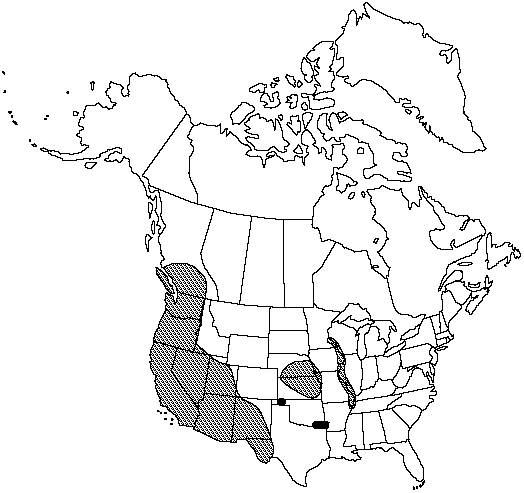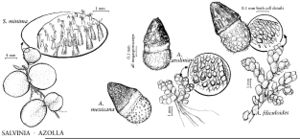Difference between revisions of "Azolla mexicana"
Abh. Königl. Böhm. Ges. Wiss. ser. 5, 3: 150. 1845.
FNA>Volume Importer |
FNA>Volume Importer |
||
| Line 16: | Line 16: | ||
}}<!-- | }}<!-- | ||
| − | --><span class="statement" id="st- | + | --><span class="statement" id="st-undefined" data-properties=""><b>Plants </b>green or often blue-green to dark red, some red-fringed leaves usually present in nature, free-floating or forming a multilayer mat to 4 cm thick in early summer; plants frequently fertile. <b>Stems</b> prostrate, 1–1.5 cm. <b>Largest</b> hairs on upper leaf lobe near stem 2(–3)-celled; broad pedicel cell often 1/2 or more height of hair, apical cell curved, with tip nearly parallel to leaf surface. <b>Megaspores</b> not covered with raised angular bumps, pitted and sparsely covered with a few long filaments extending over surface.</span><!-- |
-->{{Treatment/Body | -->{{Treatment/Body | ||
| Line 43: | Line 43: | ||
|publication year=1845 | |publication year=1845 | ||
|special status= | |special status= | ||
| − | |source xml=https://jpend@bitbucket.org/aafc-mbb/fna- | + | |source xml=https://jpend@bitbucket.org/aafc-mbb/fna-data-curation.git/src/9216fc802291cd3df363fd52122300479582ede7/coarse_grained_fna_xml/V2/V2_365.xml |
|genus=Azolla | |genus=Azolla | ||
|species=Azolla mexicana | |species=Azolla mexicana | ||
| − | |||
| − | |||
| − | |||
| − | |||
| − | |||
| − | |||
| − | |||
| − | |||
| − | |||
| − | |||
| − | |||
| − | |||
| − | |||
| − | |||
| − | |||
| − | |||
| − | |||
| − | |||
}}<!-- | }}<!-- | ||
-->[[Category:Treatment]][[Category:Azolla]] | -->[[Category:Treatment]][[Category:Azolla]] | ||
Revision as of 14:18, 27 July 2019
Plants green or often blue-green to dark red, some red-fringed leaves usually present in nature, free-floating or forming a multilayer mat to 4 cm thick in early summer; plants frequently fertile. Stems prostrate, 1–1.5 cm. Largest hairs on upper leaf lobe near stem 2(–3)-celled; broad pedicel cell often 1/2 or more height of hair, apical cell curved, with tip nearly parallel to leaf surface. Megaspores not covered with raised angular bumps, pitted and sparsely covered with a few long filaments extending over surface.
Habitat: Stagnant or slow-moving waters.
Distribution

B.C., Ariz., Ark., Calif., Colo., Ill., Iowa, Kans., Minn., Mo., Nebr., Nev., N.Mex., Okla., Oreg., Utah, Wash., Wis., Mexico, Central America, South America.
Discussion
Azolla mexicana is generally less cold tolerant and has a narrower environmental range than A. caroliniana. Both species are closely related and are similar vegetatively in culture. In the western United States, A. mexicana is often fertile. Distribution in the Great Plains area is tentative and needs further study. In the eastern United States, A. mexicana may have been occasionally introduced.
Selected References
None.
